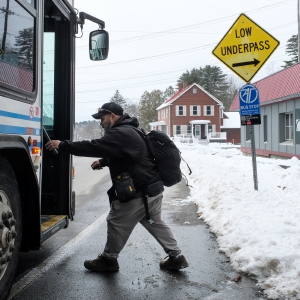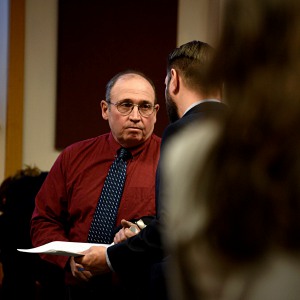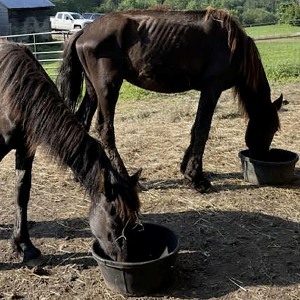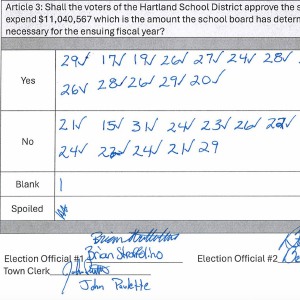High stakes for small ears: Seed stewards preserve native varieties of corn, other plants
| Published: 01-11-2020 10:16 PM |
NEWBURY, Vt. — Dried ears of Koasek corn are only about 4 inches long, much shorter and slimmer than the commercial varieties sold at the grocery store.
But Koasek corn, which is native to northern New England, isn’t for sale at the supermarket. Seed catalogs don’t carry it either, so the few gardeners who grow it depend on saving their own seeds to continue a line that has been growing here for the past 1,000 years.
“That corn is really sacred to us,” said Chief Shirly Hook of the Koasek band of Abenaki Native Americans, one of the Algonquin-speaking groups with deep roots in the Northeast.
Until recently, many native plant varieties were presumed to be lost entirely. Now, with rising temperatures and increasingly unpredictable growing seasons, scientists and seed savers have high hopes that seed varieties pre-dating the Pilgrims are perfectly evolved to withstand climate change. But will these crops survive long enough to find out?
From Colonial times to the present day, the surviving seeds have had a surprising array of stewards, like Sarah and Charles Calley, who have grown Koasek corn, uncontaminated, for 40 years on their homestead in Newbury, Vt. The corn had been lost to the Abenaki for generations, but in 2006, the Calleys returned it to the tribe, reuniting the seed with its original cultivators.
“This corn has a vitality to stay with us,” Sarah Calley said.
At the tribal garden in West Braintree, Vt., Hook grows Koasek corn alongside other rare plants that are native to the region. Hook is a slim woman, strong from tending four garden plots that are home to all of her tribe’s traditional crops. The “three sisters” — corn, squash and beans — grow alongside tobacco, sunflowers, Jerusalem artichokes and ground cherries, plants the Abenaki have raised for the past millennium.
In that time, agriculture has undergone momentous change. Contact with European colonizers marked the beginning of huge disruption to indigenous life, as new seeds and farming techniques altered the area’s food swiftly and, it appears, permanently.
The fates of the Abenaki people and their plants were intertwined as both were pushed off their land to make way for newcomers. Native people were forced to relocate from the fertile flood plains to less productive, hardscrabble land in the mountains, explained Arthur Hanchett, an Abenaki resident of Strafford. The Abenaki saved seeds from one year’s harvest, drying and storing them to be planted the following year.
Growing back
Seed saving used to be a widespread agricultural practice throughout the United States. That changed in the 1930s, when companies began breeding hybrid crops and marketing them as improved products that could create higher yields and higher profits for farmers. But hybrid seeds undermine seed saving practices because subsequent generations express recessive genes, leading to unreliable traits in the crops, a drawback detailed in the 2016 documentary Seed: The Untold Story.
By growing hybrid crops, farmers become dependent on seed companies, since they can’t save and replant the seeds these crops produce. As a result, plant diversity — the number of varieties being grown — has decreased dramatically in the past century. Researchers conservatively estimate that about 70% of crop diversity has been lost, according to the Food and Agriculture Organization of the United Nations. Other estimates are more dire: The Plant Genetic Resources Project of the Rural Advancement Foundation International set the percentage of vegetable seed varieties lost as high as 94%.
Seed saving has seen a resurgence among thrifty gardeners, as have growing heirloom and of heritage varieties. Indigenous seeds, which date back much further, are something different entirely. They are central to indigenous cultures, but many are endangered. Once lost, they are hard to recover: When a few seeds are all that’s left of an ancient lineage, every plant counts.
After raising a nearly extinct bottle gourd at the intertribal nonprofit Montpelier Dawnland Center, gardeners gave seeds from the crop to the Abenaki Heritage Garden, in Burlington’s Intervale. Two gourds matured nicely, and were almost ready for harvest when one night someone stole them, severing them at the stalk. This was a crushing loss for indigenous seed savers: What seemed like petty theft meant extinction for this gourd. The Dawnland Center had closed, and there were no more seeds.
So, when it comes to seed saving, the stakes are high, but fortunately, not all stories end in irreversible loss.
According to Koas stories, Koasek corn was passed from Abenaki farmers to early Jesuit settlers around 1675. Three hundred years later, Sarah and Charles Calley started growing the corn after it was given to them by Carroll Greene, a direct descendant of Newbury’s founder, who chartered the town in 1763. The Greenes have been growing Koasek corn since they received it from the Koasek 350 years ago. They protected it from contamination and passed it along to other local farmers, like the Calleys, their neighbors from Deering, N.H., where Sarah Calley grew up and where she met her husband.
Sarah Calley recalled Greene as “a short little elf of a man with a lot of character,” smiling at the similarity between the man and the corn: Both are “short and with vitality.”
Greene saw the corn’s success in this environment. “He wanted to spread it around,” Calley said. He apparently had good reason for doing so. The “keepers of the corn” are fond of it.
“It’s wonderful,” Calley said. “It keeps well, and it’s tasty.” Koasek corn is a sweet corn that can be cooked on the cob or ground into cornmeal. It is disease-resistant and stands up to pests like corn borers that plague modern corn varieties.
These traits have made it popular among a small pocket of local farmers for centuries. While conventional corn extracts a lot of nutrients to support stalks that grow around 6 feet tall, Koasek corn reaches only hip-height.
“They’re kind to the soil,” Charles Calley explained, whereas “big corn is tough.”
As part of the back-to-the-land movement, the Calleys were interested in what they could learn from farming practices of the past. Now they live off the grid, and, for years, they kept a herd of Devons, the small, versatile cows depicted on the Vermont flag. Growing Koasek corn is another way of staying true to the region’s roots.
While the Calleys were aware that they were growing an indigenous corn variety, they didn’t know any of their native neighbors. That changed when a woman was elected chief of the Koasek Band. Nancy Millette Doucet’s election garnered media attention, and Sarah Calley recognized Doucet when visiting a property the Calleys were selling, an old schoolhouse in Wells River: “I told her, ‘For the past 40 years we’ve been growing your corn.’ ” The two women became friends, and the Calleys handed seed corn off to the tribe in a 2006 ceremony.
“I have grown nothing else on this hillside for 40 years,” said Calley, who continues growing Koasek corn today.
Growing apart from other varieties was an important part of preserving the corn, because it’s a natural guard against cross-contamination, which occurs when one variety pollinates another. This isn’t a problem for beans, which are self-pollinating, but corn and squash need to be sequestered — different strains have to be planted a mile or more from one another so pollen doesn’t get blown between varieties.
Tony VanWinkle, a professor of sustainable food systems at Sterling College in Craftsbury, Vt., uses this technique to keep indigenous seed lines pure. Trained as an anthropologist, he has been saving seeds for the past decade.
“It’s really about a larger decolonization project,” he said. “Native Americans have made a monumental contribution to agriculture that is largely unappreciated.”
VanWinkle pointed to the “parallel discrimination” between the crops and the people.
The dark side of genetics
Vermont has a dark history of discrimination against the Abenaki that the state is just now starting to acknowledge. A state-sponsored eugenics movement in the 1920s and ‘30s forcibly sterilized 253 individuals, writes sociology professor Lutz Kaelber on UVM’s website. Many Native American women were affected.
Shirly Hook recalled two Abenaki children in her extended family who were taken by the state and sent to Brandon (Vt.) Training School, the site of forced sterilizations. She still keeps a 1932 letter from the state denying her grandfather’s petition to return the children to their family. By that time, the children had already been sterilized.
“I used to help my great aunt,” Hook said. “I could never figure out why she never had any children. All of my grandfather’s sisters were married, but they never had kids.”
Later in her life, she understood the tragic connection. Many Abenaki children were carefully instructed to conceal their native identity.
If you could pass as white, you did, Hanchett said.
“Do not ever say you’re Indian or Native American,” he recalls his grandmother saying.
His own mother had been slated for sterilization but was able to fight it in the courts.
That legacy endures, but in some ways the status of Native Americans has improved. In 2011 and 2012, four Abenaki tribes, including the Koasek, gained state recognition in Vermont. Reconnecting with traditional agriculture was an important part of this process. Sarah Calley recalled how Nancy Millette Doucet made Koasek corn a part of the tribe’s campaign for recognition.
The corn is also part of a broader effort to recover indigenous seeds. In 2012, Frederick Wiseman, of Swanton, Vt., a retired professor of ethnobotany, founded Seeds of Renewal. He has tracked down indigenous seeds from Manitoba, Canada, to Mennonite communities in central Vermont who were growing indigenous strains of ground cherries and sunflowers. His goal was to get native seeds back into circulation among native communities.
Seed science
Eric Bishop von Wettberg researches crop domestication and climate-resilient agriculture at the University of Vermont, and his lab sequences the genes of seeds that Wiseman has collected.
“Our aim is to protect crop diversity,” von Wettberg said. “One way of doing that is to celebrate the diversity of plants and to grow them.” Many commercial crops are genetically homogenous, which makes them more susceptible to pathogens and epidemics. A diversity of crops means there are more genetic traits and one variety may have resistance to a particular disease.
Sequencing a plant’s genome enables researchers to compare the plant’s DNA with an international database to find similarities and differences. Undergraduate researcher Beck Morrow, of Von Wettberg’s lab, has found that some of the beans collected by Wiseman closely resemble an Andean bean from Peru.
Gene sequencing requires materials from living plants, so UVM grows some of these native crops in a university garden. Von Wettberg’s lab also caches some of the Abenaki seeds in a chest freezer — extending their shelf life for up to 50 years. This is like a small-scale seed bank that can replenish seeds in case of emergency (like the theft of rare bottle gourds) or natural disaster.
At Sterling College, VanWinkle is working with a student to create an indigenous seed library, so that individuals can “check out” a seed that they want to grow, refreshing the stock after harvesting the next generation of seeds.
Thanks to seed saving efforts, these varieties are safer now than they were a decade ago, according to von Wettberg, and this may be a boon for farmers of the future, too. These plants have survived warmer and colder seasons in the Northeast — such as 1816, the year without a summer, when ash from the eruption of Mt. Tambora in Indonesia obstructed the sun and led to temperature drops of 3 to 6 degrees Fahrenheit. The crops also survived the Medieval warming period, from around 950 to 1250.
“This is their home,” VanWinkle said of the crops. “They do extraordinarily well here.”
Even so, farming in northern New England is a challenge some years. In mid-summer, the plots in Hook’s garden looked like they were thriving, but many farmers say 2019 was a difficult season, with cold and rain in May pushing the growing window back by 3 to 4 weeks.
“The seeds didn’t want to grow because it was so cold,” Hook said.
Hook and her partner, Doug Bent, harvest plenty to get them through the winter. Almost everything grown on the property is edible, such as dried pear from a tree on the front lawn.
Growing and preserving food is a lot of work. “It’d be nice to get children and younger people involved,” Hook said, but interest in learning to grow native crops is not particularly high among the next generation of Koasek, who are dispersed throughout the state. Hook makes sure to put her grandchildren to work when they come to visit.
No one knows for sure what next season has in store. But like their keepers, these Abenaki crops have resilience in their genes. Both have survived together for generations, showing their tenacity to stay and grow.
Amanda Gokee, grew up in Chittenden, Vt., and is a student in Dartmouth College’s Master of Arts in Liberal Studies program. She can be reached at amanda.j.gokee.gr@dartmouth.edu.
Correction
Chief Shirly Hook of the Koasek band of Abenaki Native Americans said her grandfather’s sisters were married but didn’t have kids. An earlier version of this story incorrectly quoted Hook about what relatives she was discussing.
]]>
Yesterday's Most Read Articles
 Upper Valley winter shelters kept dozens warm and dry
Upper Valley winter shelters kept dozens warm and dry
 Former principal of South Royalton School released from prison
Former principal of South Royalton School released from prison
 Owner of Friesian horse facility ordered to pay care costs for seized animals
Owner of Friesian horse facility ordered to pay care costs for seized animals

 Hartland voters successfully petition for school budget revote
Hartland voters successfully petition for school budget revote 
